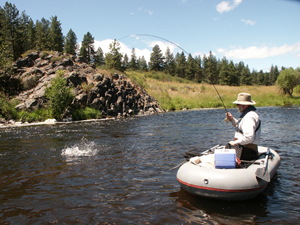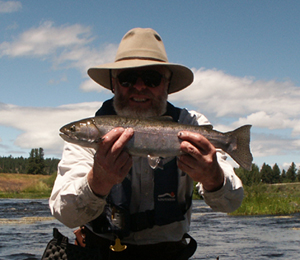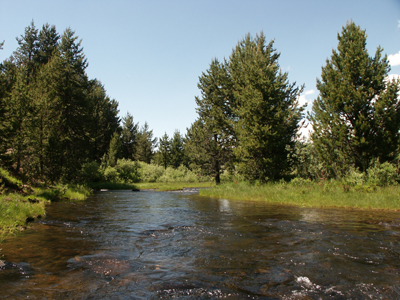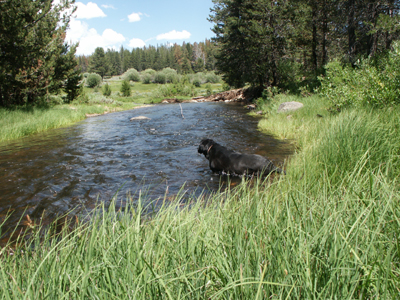South Central Oregon
Closest town: Chiloquin
Closest city: Klamath Falls
Boat Launch: County Park on the edge of town
Boat Exit: Water Wheel Campground six miles down river on Hwy. 97
Recommended guide book: Moon Outdoors Oregon Fishing

Having fished and guided in Montana for over twenty years, I wouldn’t go so far as to proclaim Oregon’s rivers on par with Montana for wild rainbows, but I am feeling less remorse regarding my move from the Bitterroot Valley to the Klamath Basin each time that I have float fished the Williamson River. Do not infer from this assertion that I have probed the depths of this river and gleamed the secrets for successful fishing. Indeed, the opposite is true. Of my two forays, last October and my most recent trip mid-July, 2006, I have managed to land only four fish. The smallest was sixteen or seventeen inches and the largest was perhaps twenty inches. The three guide books that I have read proffer the same advice, cover the same recommendations and dangle an irresistible carrot on a fly rod. Dear readers, who amongst you is not interested in targeting a wild 5 to 10 pound rainbow trout on a small river?
Fishing for these “black monsters” is akin to fishing for steelhead. Klamath Lake rainbows are arguably a strain of steelhead according to some experts. Due to the tannic, tea colored water, Klamath trout are dark, lead-colored later in the summer, and they are generally on the move. Locked in a shallow lake with an average depth under ten feet, the Klamath Lake grows lots of bugs, forage fish and algae. When the algae blooms and the shallow waters heat to potentially lethal levels for trout, they move! Underwater springs and the mouth of the Wood River and the Williamson River become staging areas for these stressed trout. From late June through October these stressed trout seek sanctuary in the Williamson River. (The Wood River has been altered by BLM management to the point that a sand bar impedes progress up river.) Cooled by Spring Creek a few miles above Chiloquin at Collier State Park, the river harbors incredible numbers of huge fish beating the heat of summer. Sounds like an angler’s dream, but in order to protect these vulnerable fish, Oregon fishing regulations require that an angler not float and fish above the Chiloquin County Park; further, anglers can not anchor and fish nor tie up their boat and fish from the boat. Since the banks are all private property, you can’t get out and fish! When you float down to the residential section and see the pods of fish all schooled up in front of homes, you are also stymied in that if you jump out of your boat to fish from the river bottom, you had better have the stature of an NBA player because it is deep. The guide books point out that by October some fish reach the Collier State Park and hold up at the confluence of Spring Creek. Floating from Collier State Park to Chiloquin is a great float for a small raft or canoe, but be sure to get out at the bridge in Chiloquin by the market because downstream is a drop-off that could easily tear up a raft or damage a boat. So, where are these famed floating sections that fishing magazines tout? They are on the upper river on private ranches, but there is one six mile section the public can float and cast while drifting.
Exiting Highway 97 for the town of Chiloquin, the rodeo grounds are on the left and the county park with access to the river is on the right. Because the bank is so steep, the county has a wood boat slide to the river, although drift boats are generally dropped down the steep bank with four-wheel drive trucks. Most of the guides launch and then row up stream 200 yards to where the Sprague River joins the Williamson River. This confluence, the “Blue Hole” can also be reached by driving behind the Chiloquin High School where it is easy to launch a small raft or kick boat a hundred yards from the confluence. The best waters on this five to six mile float are the first two miles. Like the Big Horn River in Montana, guides scurry to the best holes, anchor and spend upwards to two hours in a hole. If you can afford a guide, do so. It can be a challenging fishery. Take your time fishing the upper river slowly and methodically. Remember, this is a stream that you are fishing for a trophy trout, not a slew of dinks.
During the run-off in May, I swung by the boat launch to check out the water conditions on my way to the hardware store. When I pulled up a boy was on the wooden launch tying on a Crocodile Lure. About a foot up from the lure, he attached a big chunk of lead. He made a quarter cast upstream and reeled it in way too fast in my estimation. On his fourth cast he nailed a six or seven pounder. He wasted no time horsing it in only to have it flip off in the weeds next to his feet. I could see he was ready to jump in after it as it flailed in the weed mat. I yelled to him not to jump. The water was over his head, cold and swift. He nonchalantly turned to me and said, “It’s all right. I’ve caught bigger ones than that on this river.” He then turned to me and graciously said, “Would you like to make some casts, mister?”
“No, thanks,” I said stupidly. It was a sincere offer. He wasn’t in any hurry to catch another fish. He was alone and saw how excited I was with his catch. I am still puzzling over why I didn’t accept this 10-year old’s offer. What kept me from saying ‘Hell, yes!” and bailing out of the truck. It honestly wasn’t pride. I think I was afraid I wouldn’t give him back his outfit.
With such a limited knowledge of this world-class stream, it is not prudent to provide tips and tactics. However, if you are like me and can not afford a guide, let me share with you my experience and what I have learned from the guide books and anglers that I have met. First of all, this is not a classic dry fly fishery. Yes, the river has prolific hatches, especially the Hexagenia hatch in late June and early July, but unless you hit it just right and the fish are wont to feed on top, you need to provide them food that they are more accustomed, which corresponds to their feeding regimen in the lake. In other words, streamers, wet flies and nymphs are the preferred flies for these monsters. Last October I caught both fish on a size 8 Yuk bug. My son broke off at least four large fish in a nice side channel with a riffle at the top dumping into a run. A few nights later he went back and landed a 20-incher with a Denny Rickards Seal Bugger. He used an intermediate sinking line and allowed the fly to sink before he retrieved it with short, hand retrieves punctuated by a pause after three quick, short retrieves. On my second trip to the river recently, I decided to experiment.
I know the river produces a good supply of crawdads so in addition to my fly rod I brought a bait casting reel. I tied a 2-inch red tube bait and ran it through a fast run. I honestly don't know if these lake trout will take a crawdad, but I kept getting light hits until I hooked up a nice fish. For the next couple of hours I was constantly hanging up on the bottom, and I had no hits. Later in the day a guide floated by me in the slow frog water. He asked me how the fishing had been and I said slow. He laughed and said, “Well, you’re not going to catch anything with that monstrosity.”
“Well, I caught my first fish on that monstrosity,” I replied.
“There’s always a few dumb ones around,” he countererd.

Having been a fly fishing guide, I know how familiar and knowledgeable a guide can become on his home waters, but I also know guides who become arrogant and close-minded. I had just caught an 18+ inch rainbow using a tube bait and a PMD nymph as a dropper on a fly rod! I know I am going to catch some big fish on small tube baits. Here are what the experts advise. If you have had success on this stretch and are willing to share with others, I would really like to hear from you, especially on fishing the frog water.
1. Big Streamers
2. Wooly Buggers, Yuk Bugs
3. Leeches and Seal Buggers
4. Standard nymphs with strike indicators.
Guest Contributor:
The following is an excerpt from Craig Schuhmann’s web site on the Williamson River and Wood River. Craig is an Oregon licensed fishing guide and may be contacted at 541-778-1194, or he may be reached at his email at crsscs@hotmail.com. His newly published book, Moon Outdoors: Oregon Fishing is a comprehensive fishing guide to the entire state of Oregon including coastal areas. It is now my first choice for Oregon fishng guides.
The Williamson River is a blue-ribbon, trophy trout spring creek located in Southern Oregon, 30 miles north of Klamath Falls. This is the river made famous by E.H. Polly Rosborough in his book, Tying and Fishing the Fuzzy Nymphs. "Polly" was a West Coast pioneer in fly design and matching the hatch, and dedicated most of his life and writings to understanding this complicated fishery. Dick Winter, a former tyer of Polly's, still fishes the river today and has developed his own great series of flies for taking trout such as his Black Drake Spinner and Hexagenia patterns.
The river originates in the Winema National Forest and is divided into two sections: the upper river above Klamath Marsh and the lower river flowing through Chiloquin and into Upper Klamath Lake. These two distinct river sections, are quite different as fisheries.
Lower River: Most of our guiding occurs on the lower river and is concentrated on catching large migratory Upper Klamath Lake Redband Trout which have genetic links to steelhead. Average catches range from 4-7 pounds with 10 pound (30 inch) fish not uncommon. Highlights include the emergence of Hexagenia (large yellow mayfly) and PMD's in June and July, Tricos in August, and Mahogany Duns and BWO's into fall. Streamer fishing is by far the most productive method for catching these large predators. We use full sinking lines much of the year and our best streamers are seal buggers, various leech patterns. Soft hackles and nymphs are also productive.
Upper Williamson: The upper river is equally exciting with abundant hatches of Hexagenia (July) and Black Drakes (June) for slightly smaller redbands and brook trout. This is a walk-in fishery, quaint in size and character. The drive to this location is about an hour- and- a half from Chiloquin. This is a great way to spend a day stalking spooky trout feeding in tight bends and small channels, examining hatches and eating lunch under the giant Ponderosa Pines.
"The Wood River will find its nitch in the heart of every spring creek angler."
Originating at a large spring in Kimball State Park northeast of Fort Klamath, the Wood is a spring creek that will test every angler's ability. Fish for large resident browns up to ten pounds in the spring and summer and migratory rainbows in the fall. A day on the Wood is a visual splendor and solitary retreat. Owls, hawks, eagles, foxes, otters, mustkrats, beavers, wildflowers, and mountain views will be your companions as we float in search of feeding trout on the gentle gin-clear waters.
Fishing on the Wood occurs from May 1 - October 31. Highlights include early season hatches of PMD's in May, June and July, followed by an assortment of green drakes, BWO's and other mayflies and caddis. In August, it's grasshopper season and time to throw large grasshopper patterns against the banks. Fall brings out a hatch of BWO's and Mahogany Duns that rival the early season PMD hatch in size. One can always bring bigger browns to hand with streamers and sinking lines.
Craig Schuhmann

